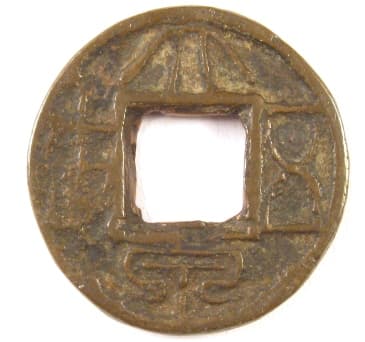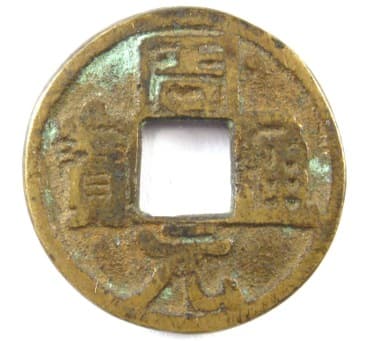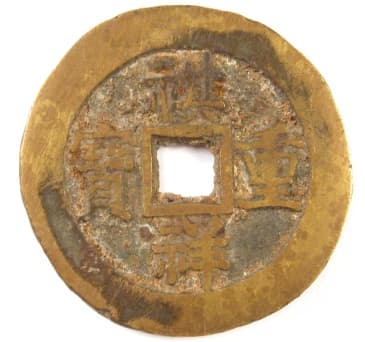
Chinese Charms with Coin Inscriptions

The mythical power of the
written Chinese language along with the authority of the
Chinese empire have traditionally combined to make Chinese coins into something
more than just a form of currency.
For this reason, people believed that by utilizing the inscriptions (legends) of certain Chinese coins, the power of charms would be further enhanced.
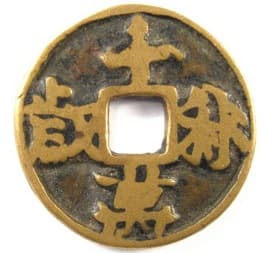 Some coin inscriptions are used on charms
because they have an inherent auspicious meaning. For example,
the inscription on the Liao Dynasty (916-1125
AD) qian qiu wan sui
(千秋万岁) coin at the left expresses the hope for
longevity with the meaning of "a thousand autumns
and ten thousand years". This
Liao Dynasty coin is described in more detail below.
Some coin inscriptions are used on charms
because they have an inherent auspicious meaning. For example,
the inscription on the Liao Dynasty (916-1125
AD) qian qiu wan sui
(千秋万岁) coin at the left expresses the hope for
longevity with the meaning of "a thousand autumns
and ten thousand years". This
Liao Dynasty coin is described in more detail below.
Another example would be the zheng de (正德) reign title of Ming Dynasty (1368-1644 AD) Emperor Wu Zong. Zheng de (正 德) means "correct virtue". The inscription zheng de tong bao (正 德通 宝), meaning "currency of correct virtue", became a very popular inscription on Chinese charms even though no actual coins with this inscription were ever cast by the government! Please see the examples below.
Other Chinese coin inscriptions seem to have been used on charms because the coins were issued during a time of disunity and unrest which the Chinese people, unfortunately, have faced many times throughout their history. Charms using the coin inscriptions of Wang Mang (7-23 AD), whose monetary reforms brought unprecedented disorder, belong to this category. Several examples are illustrated in the section below.
Still other Chinese coin legends were used because of a perceived force in the metal used in the casting of the coins of that era, such as the Later Zhou Dynasty (951-960 AD) zhou yuan tong bao (周 元通宝) charms.
Examples of these and other charms with coin inscriptions are discussed in more detail in the sections below.
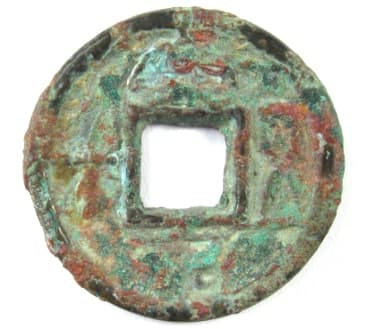
Wang Mang usurped the throne in the year 7 AD and proceeded to institute a number of monetary reforms which became extremely unpopular.
One of the first coins Wang Mang introduced had the inscription da quan wu shi (大泉五十) and the coin with the colorful and heavy patina at the left is an example. The character above the square hole is da (大) meaning "big". The character below the hole is quan (泉) which translates as "coin". The character on the right is wu (五) which means "five" (5). The character on the left is shi (十) meaning "ten" (10). The value is therefore 5 x 10 = 50. The inscription thus means "large coin fifty". The coin was declared to be the equivalent of 50 of the Han Dynasty wu zhu (五铢) coins which were the prevailing currency up to this time.
The reverse side of this coin is blank.
The coin has a diameter of 31 mm and a weight of 9.3 grams.
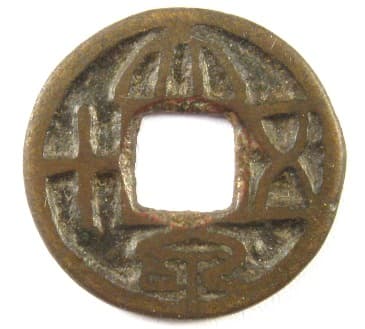
The "coin" to the left is not to scale.
It is actually a charm that has the same inscription (da quan wu shi 大 泉五十) and resembles the coin above.
It is very small and is certainly old, although it probably does not date to the time of Wang Mang.
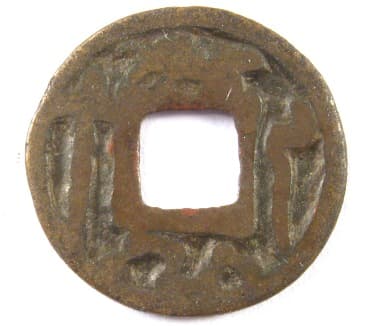
Because of wear, the symbols on the reverse side are a little difficult to discern. To the right of the square hole is a snake with its head at the top and cocked back. To the left is a sword with its hilt at the top. Above the hole is a tortoise with its head facing to the right, and below the hole are the seven stars of the Big Dipper constellation all connected together by a line.
The tortoise has a long life-span and the snake is one of the five poisons. These two animals would eventually become entwined to become Xuanwu (玄 武), also known as the Black Warrior.
The sword is a weapon able to cut through ignorance and slay evil spirits.
"Longevity" is the overall implied meaning of these symbols. (Please see Hidden Meaning of Chinese Charms for more detailed information.)
This charm has a diameter of only 19 mm weighs just 1.5 grams.
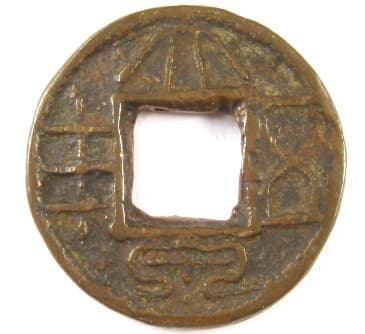
This is a very interesting da quan wu shi (大泉五十) coin. If you look carefully at the Chinese character shi (十), meaning "ten" (10) to the left of the square hole, you will notice that it has not one but three horizontal lines. The Chinese character shi (十) for "ten" only has one horizontal line. The additional horizontal lines seems to mean that the coin is not worth 5 x 10 = 50 coins, but rather 5 x 30 = 150 coins!
Another characteristic of this coin is that the inscription is repeated on the reverse side thus making it a "double obverse" coin.
There seems to be some disagreement as to whether this specimen is actually a coin or a charm but I am treating it here as a charm.
The charm has a diameter of 25 mm and a weight of 8.2 grams.
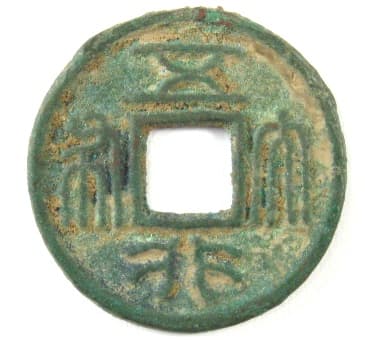
At the left is a Northern Zhou Dynasty coin cast in the year 574 AD during the reign of Emperor Wu.
The inscription is wu xing da bu (五行大布) which translates as "large coin of the five elements".
The five elements consist of metal, wood, water, fire and water.
For a discussion of the five elements please see Charm Symbols: Star, Moon, Cloud and Dragon.
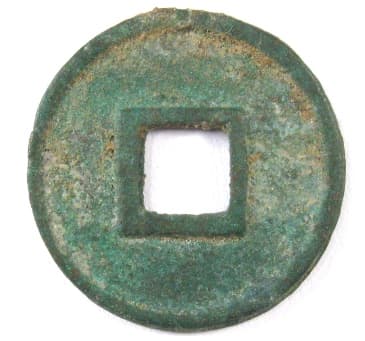
The reverse side of the coin is blank.
The coin has a diameter of 26 mm and weight of 3.7 grams.
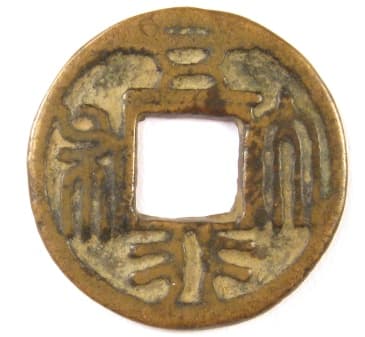
This is a charm written in the same seal script and with the same inscription or legend (wu xing da bu 五 行大布) as the coin above.
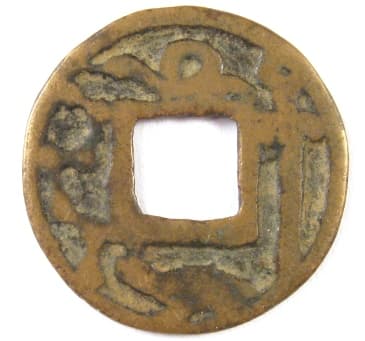
The reverse side displays the same four symbols, namely the snake, tortoise, sword and the Big Dipper constellation, as on the Wang Mang da quan wu shi (大 泉五十) charm discussed above.
On this charm, however, the sword is on the right and the seven star Big Dipper constellation is on the left.
Above the square hole is the snake which is coiled with its head facing to the left.
The tortoise is below the square hole with its head also facing to the left.
The charm has a diameter of 24.5 mm and a weight of 3.7 grams.
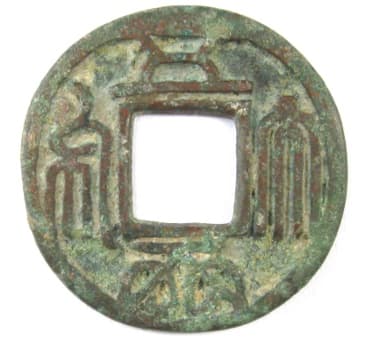
This obverse side of this large charm is based on the same Northern Zhou Dynasty coin and uses the same seal script calligraphy.
If you observe closely, though, the character at the bottom is written differently. Most experts still consider this character to be the same character 行 (xing) as on the Northern Zhou coin displayed above.
Others, however, believe that the character is actually 两 (liang) which was a unit of weight. The liang was the same unit of weight used, for example, on the Qin Dynasty (221-207 BC) and Western Han Dynasty (206 BC - 220 AD) banliang (半两) or "half tael" coins.
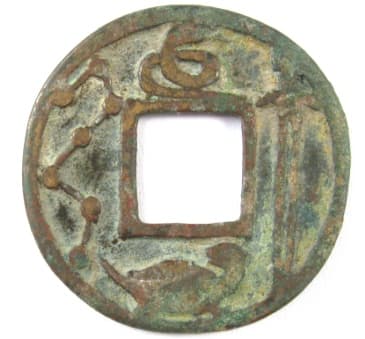
The reverse side has the same four symbols in the same location as the smaller charm above. The difference is that the snake is coiled differently and its head at the top facing right.
Also, the tortoise with its head on the right is now looking back towards the left.
The diameter of this charm is 32.5 mm and the weight is 7.3 grams.
The obverse side of this charm closely resembles that of the coin above and the inscription, zhou yuan tong bao (周元通宝), is the same.
Although this charm is from a later period, charms with this Chinese coin inscription are very popular.
Because the actual coins with this inscription were cast using bronze from Buddhist statues, the Chinese believed that this was also true for charms and amulets with the same inscription even though they may have been cast in the following centuries.
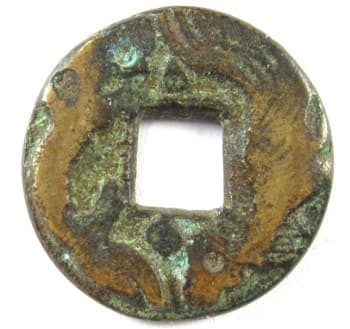
The reverse side of this old charm has a dragon on the left and a phoenix on the right.
The two are facing each other with their heads at the bottom of the charm.
Charms with a dragon and phoenix are considered auspicious marriage charms.
For additional information on this theme, please visit Chinese Marriage Charms.
The diameter of the charm is 22.5 mm and the weight is 5.6 grams.
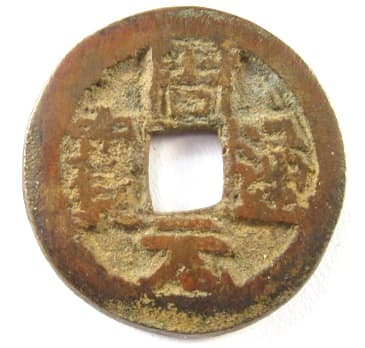
Like the charm above, the obverse side of this charm has the auspicious Chinese coin inscription zhou yuan tong bao (周元通宝).
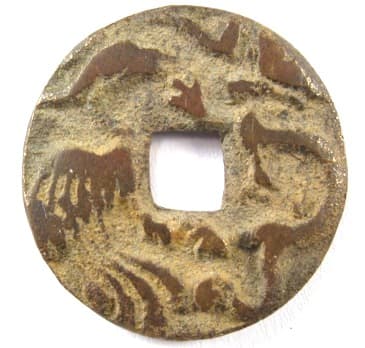
This is the reverse side of the charm revealing that it is another phoenix and dragon marriage charm.
In this example, however, the phoenix is on the left and the dragon is on the right. The two are facing each other with their heads at the top of the charm.
It is a little difficult to see but the wings of the phoenix are just to the left of the square hole. The head is at the eleven o'clock position and the tail feathers are at the seven o'clock position.
The dragon is on the right with the tip of its mouth at the twelve o'clock position and a dot representing its left eye at the one o'clock position. Its left front claw is just above the square hole. The dragon's body curves down the right side of the charm and its left rear claw is just below the central hole. Its tail is almost touching the upper tail feather of the phoenix.
The charm has a diameter of 25 mm and a weight of 6.6 grams.
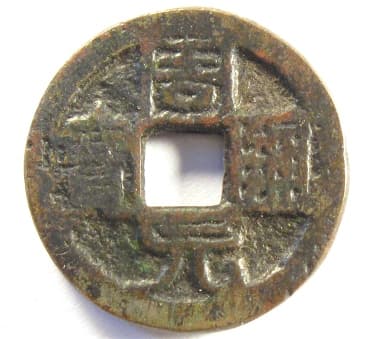
This is the obverse side of another ancient charm based on the zhou yuan tong bao (周元通 宝) coin of the Later Zhou Dynasty.
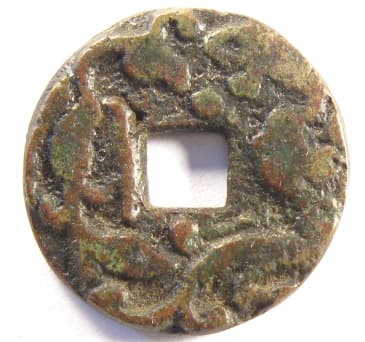
Similar to the example above, the dragon is on the right and the phoenix is on the left.
The two mythical animals are sculpted in high relief and are facing each other with their heads at the top of the charm.
This charm has a diameter of 23.5 mm and a weight of 6.8 grams.
(960-1279)
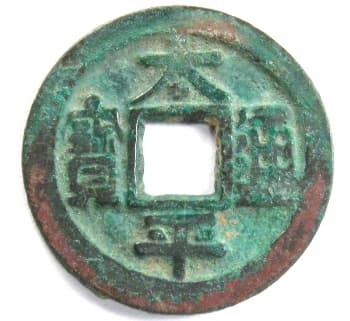
The coin displayed at the left is an example of coins with the inscription tai ping tong bao (太 平通宝) cast during the years 976-989 of the reign of Emperor Tai Zong (976-997) of the Northern Song Dynasty.
This was the first Song Dynasty coin inscribed with an imperial or reign title.
The reign title tai ping (太 平) means "peace".
This same inscription, tai ping tong bao (太 平通宝), was also used on coins cast during the years 1854-1855 by the Shanghai Small Sword Society (xiao dao hui 小刀会) during the Taiping Rebellion (1850-1864).
The coin has a diameter of 24.8 mm and weighs 4 grams.
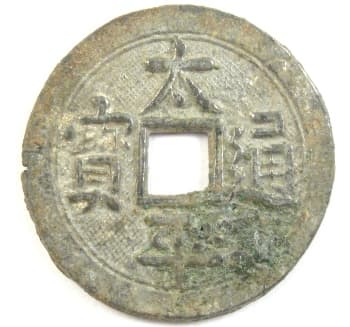
This is a charm based on the tai ping tong bao (太 平通宝) coin of the Song Dynasty.
Tai ping, meaning "peace" or "great peace", has always been a strong desire of a people and it is, therefore, an appropriate inscription for a charm.
This is an unusually well-made charm as evidenced by the fine crosshatch pattern seen in the character field.
The charm appears to be made of tin with, possibly, a silver wash.
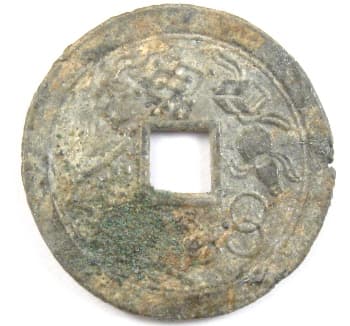 The
reverse side of the charm displays a number of
auspicious symbols, some of which are
difficult to identify.
The
reverse side of the charm displays a number of
auspicious symbols, some of which are
difficult to identify.
At the top is a pair of interlocking diamond-shaped lozenges known as fang sheng (方胜). The origin of this symbol is still unclear but it may represent the form of an ancient musical instrument. Or, it may have been a head ornament worn in ancient times which symbolized victory. There is also a legend that the Queen Mother of the West wore such as object to exorcise evil spirits.
Moving clockwise, the next symbol appears to be books tied with a ribbon or fillet possibly expressing the wish for sons to be successful in the imperial exams and obtaining an official government position.
The next symbol is a gourd also tied with a ribbon. The gourd is popular symbol to ward off evil spirits and disease because its first character (hulu 葫芦) has the same pronunciation as to "protect" or "guard" (hu 护), and also for "blessing" (hu 祜). (Please see Gourd Charms.)
Unfortunately, corrosion obscures the symbols at the bottom and left of the square hole and these symbols remain unidentified.
Just to the left of the lozenges is a flaming pearl which represents riches and wealth.
This charm has a diameter of 26 mm and a weight of 3.3 grams.
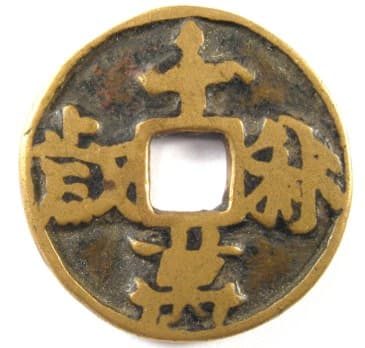
At the left is a fairly rare coin charm from the Liao Dynasty.
According to historical records, Emperor Tai Zong (太宗) in the year 938 established the capital at Shang Jing (上京) and honored the event by casting commemorative coins with the auspicious inscription qian qiu wan sui (千秋万岁), which literally translates as a "thousand autumns and ten thousand years", expressing the hope that the emperor and the dynasty would endure forever.
Most of these commemorative coins were presented as gifts or awards. Some of the coins have also been found in the foundations of Liao Dynasty pagodas where they were presented as offerings by religious believers during the dedication of the religious buildings.
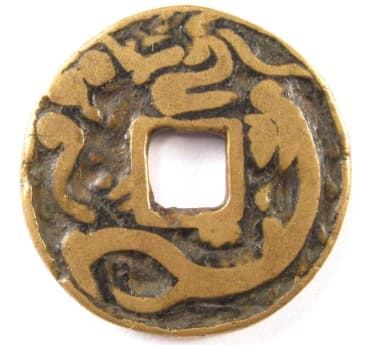
The reverse side displays an interesting set of three figures.
At the very top is a figure of a person kneeling with his right and left arms stretched out.
To the left of the square hole, and below the above figure's right arm, is a person, perhaps a newborn child, bent forward and standing.
To the right of the hole, and below the top figure's left arm, is a dragon.
This Liao Dynasty coin has a diameter of slightly greater than 25 mm and a weight of 6.8 grams.
(1115-1234)
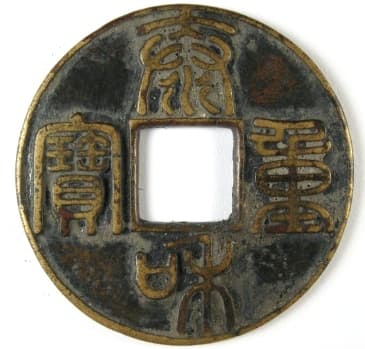
During the late Northern Song Dynasty, the Nuzhen (Jurchen, Jurched) (女真) nationality conquered most of north China and established their rule as the Jin Dynasty.
At first, they used coins of the Song and Liao dynasties but began to cast their own coinage in 1157.
The coin at the left, with the beautiful seal script calligraphy, has the inscription tai he zhong bao (泰和重宝).
The coin was cast during the years 1204-1209 of the reign of Emperor Zhang Zong (1190-1209) of the Jin Dynasty.
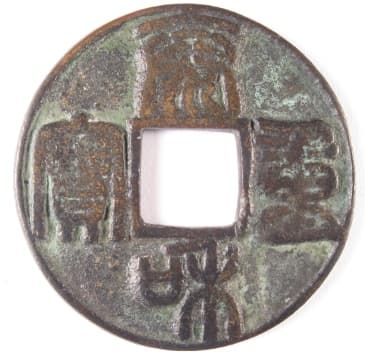
This is actually a charm based on the Jin Dynasty tai he zhong bao coin shown above.
Because tai he (泰和) can be variously translated as "peace and harmony" or "prosperity and harmony", the coin became popular as a theme upon which to base charms and amulets.
Tai (泰) can also refer to tai shan (泰 山), or Mt. T'ai, which is a famous and sacred mountain worshipped as a god.
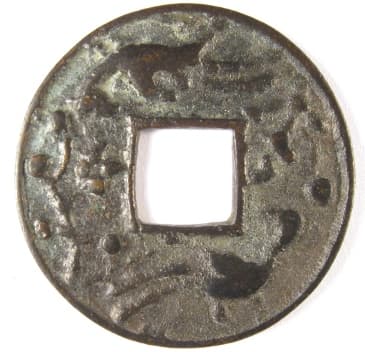 The reverse side of
the charm depicts two magpies with
their long tail feathers. The magpie above the
square hole is actually upside down. Its head is
looking down and back to the right.
The reverse side of
the charm depicts two magpies with
their long tail feathers. The magpie above the
square hole is actually upside down. Its head is
looking down and back to the right.
The magpie at the bottom has its head at the four o'clock position and is looking up and to left.
The two magpies are therefore looking directly at each other.
The magpie (xi que 喜 鹊) symbolizes "happiness" because the first character xi is the same as the word "happy" (xi 喜). Two magpies facing each other therefore represents "double happiness" (shuang xi 喜喜) and is a symbol of a happy marriage.
The reference to a happy marriage is based on the legend of two heavenly lovers, the Cowherd (Oxherd) and the Weaver Girl (Maiden), who are permitted to meet each other only once a year on the seventh day of the seventh month (known as qixi 七夕, the Double Seven, or Sisters Festival) by crossing a celestial river (the Milky Way) on a bridge made of magpies.
Also, a magpie shown upside down, as is the case here, means that happiness has "arrived" because the Chinese words for "upside down" (倒) and "arrived" (到) are both pronounced dao.
Located between the two magpies are plum branches. In Chinese, one can say "there is a happy bird (magpie) on the tip of the plum branch" as xi shang mei shao (喜上梅稍). This sounds exactly the same as saying xi shang mei shao (喜上眉稍), meaning "happiness up to one's eyebrows", which is a Chinese expression for "very happy".
This charm has a diameter of 41 mm and a weight of 18.8 grams.
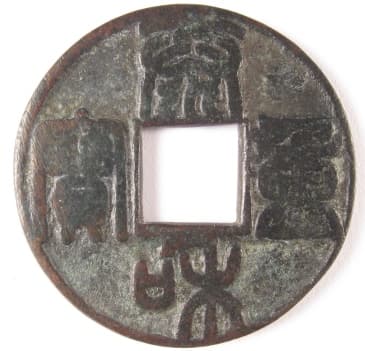
This is the obverse side of another charm based on the famous tai he zhong bao (泰和重宝) coin of the Jin Dynasty.
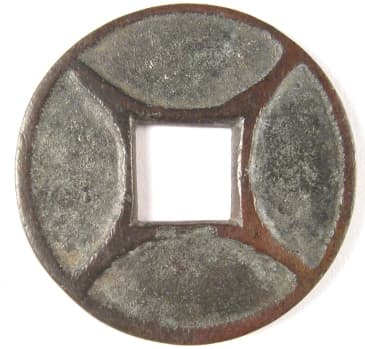
The reverse side of the charm has four lines radiating outward from the corners of the square hole and extending to the rim.
The Chinese refer to this characteristic as si chu (四出). Si (四) means "four" and chu (出) means "going out".
The implied meaning is that peace, prosperity and harmony should radiate in all directions.
The charm has a diameter of 41 mm and a weight of 22.3 grams.
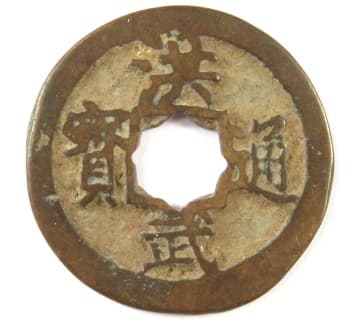 This coin was
cast during the reign of the first emperor of the Ming
Dynasty.
This coin was
cast during the reign of the first emperor of the Ming
Dynasty.
The inscription is hong wu tong bao (洪武通宝) and was cast during the Hong Wu reign of Emperor Tai Zu (1368-1398).
You will notice that the hole is not in the usual shape of a four-sided square. This particular specimen has an auspicious eight-sided hole known as a "flower" or "rosette" hole.
"Flower hole" coins were fairly common during the Northern Song and early Southern Song Dynasties but became very rare by the time of the Ming Dynasty.
A detailed discussion of these types of coins including many examples can be seen at Chinese Coins with Flower Holes.
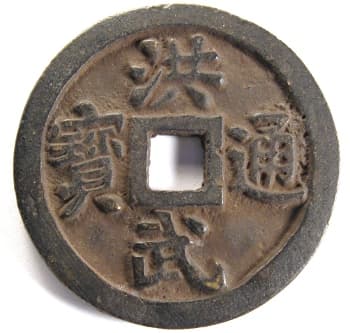
This is a Chinese charm, modeled after the above Ming Dynasty coin, with the same inscription hong wu tong bao (洪武通宝).
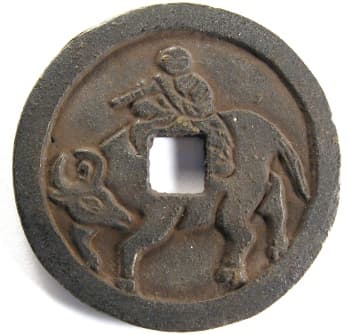 The
reverse side of the charm shows a boy riding an ox or
water
buffalo.
The
reverse side of the charm shows a boy riding an ox or
water
buffalo.
In this case, the "boy" is actually Emperor Tai Zu.
Emperor Tai Zu had a very humble early life and for a time was a shepherd boy.
You will notice that the boy is playing a flute which has the connotation of a care free life.
The flute is an old Daoist (Taoist) symbol which is associated with the Daoist Immortal Lan Caihe (蓝采和).
The flute is also an ancient Buddhist symbol used in meditation and is displayed on this charm to allude to the time when Emperor Tai Zu lived in a Buddhist monastery.
This type of charm became popular with the Chinese people because it represented the hope that a person could become successful despite being born into a peasant family.
Another hong wu tong bao charm which displays a number of symbols referring to Emperor Tai Zu's life is discussed in detail at Buddhist Charms.
This charm has a diameter of 43 mm and a weight of 29.2 grams.
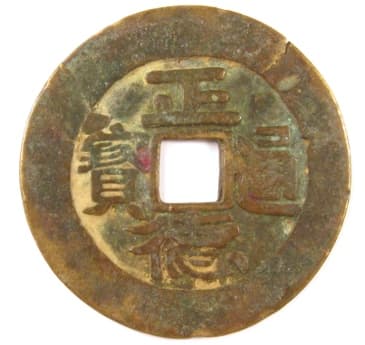
The inscription (legend) on this charm is zheng de tong bao (正德通宝).
Zheng De was the reign title (1505 - 1521 AD) of the Ming Dynasty Emperor Wu Zong. While some claim that the government did cast a very small number of coins with this inscription, it is generally believed that no coins meant for circulation were ever cast by the government using the reign title zheng de.
Even though no legal tender coins were cast during this period, a fairly large number of charms with this inscription exist. The reason is that zheng de has the auspicious meaning in Chinese of "correct virtue", so the inscription translates as "currency of correct virtue".
Many Chinese of the time also believed that Emperor Wu Zong was the reincarnation of a real dragon.
Ancient Chinese folklore says that zheng de was a "swimming" dragon. The belief is that wearing a zheng de charm when you cross a river or sea will protect you from the danger of large waves.
The Chinese also love to gamble and there is an old Chinese superstition that says carrying a zheng de charm will bring you good luck at gambling.
It was believed that if a pregnant woman carried a zheng de charm in her hand both she and her child would be protected.
Zheng de charms were also given to children as a form of good luck money (yasuiqian 压岁钱) during the lunar New Year.
The zheng de charms were considered so lucky that there was this popular saying:
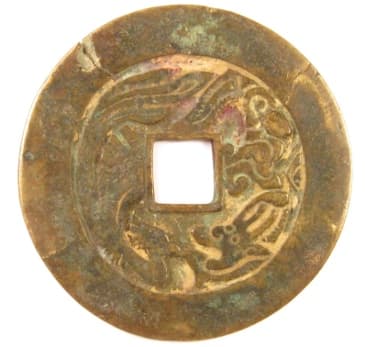
It is a common theme with zheng de charms to have a dragon and phoenix.
The reverse side of this charm shows a wide-eyed dragon on the right with its head at the five o'clock position. A lovely phoenix is on the left of the square hole with its head at the six o'clock position.
The dragon and phoenix paired together represent the ultimate union of a man and a woman. Additional information on this subject can be found at Chinese Marriage Charms.
The charm has a diameter of 45 mm and weighs 14.5 grams.
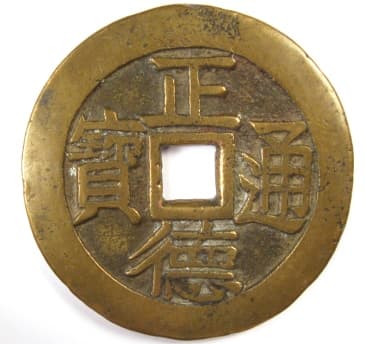
This is another example of a very well-made zheng de tong bao (正德通宝) that would typically have been used as a marriage charm.
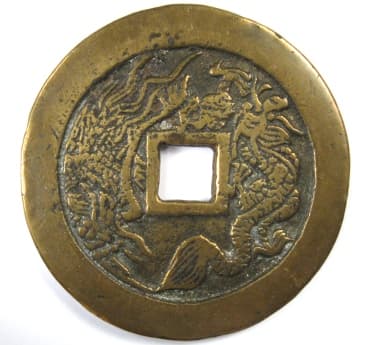
The reverse side of the charm displays a very ornate and finely detailed dragon on the right with its head at the two o'clock position.
An equally detailed phoenix is at the left of the center hole with its head at the eight o'clock position.
This is a large and heavy charm.
The diameter is 54 mm and the weight is 42.3 grams.
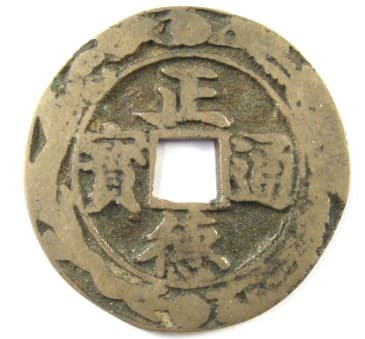
This is another example of a charm with the Chinese coin inscription zheng de tong bao (正 德通宝).
The very broad outer rim displays a dragon on the left and a phoenix on the right.
The circular objects at the 12 o'clock and 6 o'clock positions are pearls.
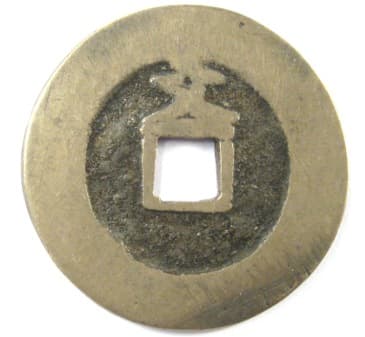
The reverse side also has a very broad outer rim with the single Chinese character wen (文) above the square hole.
Wen (文) is the measure word used for counting Chinese cash coins.
It is interesting that this same character wen (文) can also mean the obverse side of a coin even though here it is displayed on the reverse side.
The diameter of this charm is 31.3 mm and the weight is 8.3 grams.
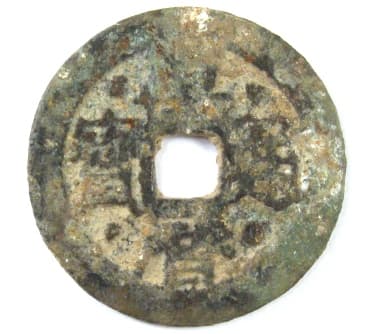
Coins were cast with the reign title Wan Li (万历) of Emperor Shen Zong during the years 1573-1620 of the Ming Dynasty.
At the left is a coin with the inscription wan li tong bao (万历通宝).
What is unusual about this coin is that there are four dots, with one dot between each of the Chinese characters.
Experts seem to be divided as to whether this is an official coin or a charm.
The character wan (万) means "ten thousand" and the character li (历) means "era" or "calendar". The four dots are generally believed to represent stars (xing 星) or suns (ri 日). The implied meaning is, therefore, light and brightness forever.
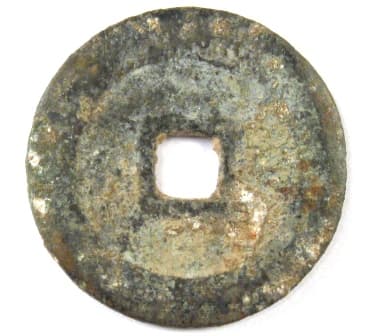
The reverse side of this coin or charm is blank although it has the same broad outer rim as that on the obverse.
The coin has a diameter of 24 mm and a weight of 3.4 grams.
(1644-1911)
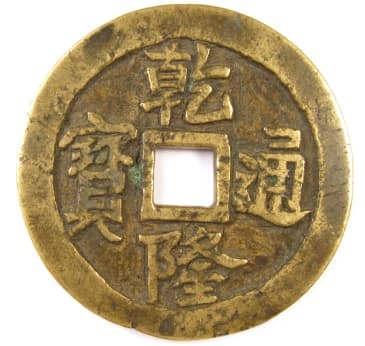
This coin is a qian long tong bao (乾隆通宝) presumably cast during the 60 year reign (1736-1795) of Qing (Ch'ing) Dynasty Emperor Gao Zong.
The coin is very large and heavy. In fact, it is much larger and heavier than any other qian long tong bao variety of coin with which I am familiar.
Also, the characters, such as the bottom portion of the bao (宝) and the radical portion of the tong (通), are written in a slightly different style from that of the other coins of this emperor.
The coin, however, is clearly old.
Because of its size, calligraphy and age, I have concluded that this "coin" is most probably a "charm".
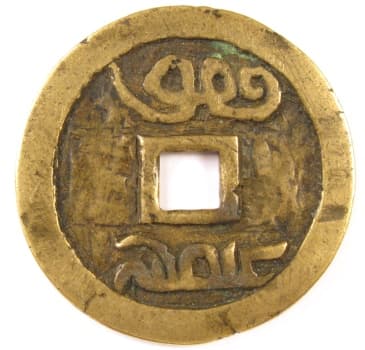
The reverse side reveals another interesting feature.
The Manchu characters indicate that the piece was cast at the Board of Revenue in Peking (Beijing).
However, the characters are rotated 90 degrees clockwise and the characters themselves are very large.
The intention may have been political but the meaning remains unclear.
The charm has a diameter of almost 56 mm and a thickness of just over 3 mm.
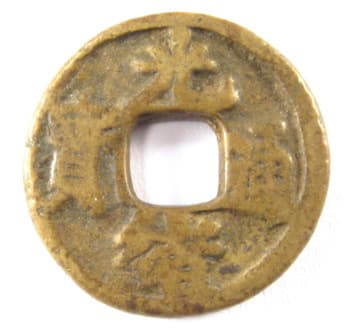
The charm to the left is quite small and shows considerable wear.
The inscription is guang xu tong bao (光绪通宝) and the obverse side looks exactly like a typical Qing (Ch'ing) Dynasty coin of Emperor De Zong (1875 - 1908 AD).
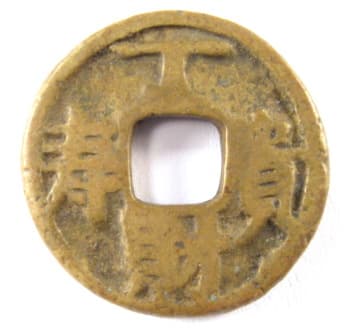
The reverse side reveals that it is actually a charm with the inscription read top to bottom and right to left as ding cai gui shou (丁财贵寿).
The translation is "May you acquire wealth, honor (high rank) and longevity".
The charm is only 19.5 mm in diameter and weighs 4.7 grams.
If you have a further interest in the close relationship of Chinese coins and Chinese charms, please also visit Chinese Coins with Charm Features.
Return to Ancient Chinese Charms and Coins
For this reason, people believed that by utilizing the inscriptions (legends) of certain Chinese coins, the power of charms would be further enhanced.
 Some coin inscriptions are used on charms
because they have an inherent auspicious meaning. For example,
the inscription on the Liao Dynasty (916-1125
AD) qian qiu wan sui
(千秋万岁) coin at the left expresses the hope for
longevity with the meaning of "a thousand autumns
and ten thousand years". This
Liao Dynasty coin is described in more detail below.
Some coin inscriptions are used on charms
because they have an inherent auspicious meaning. For example,
the inscription on the Liao Dynasty (916-1125
AD) qian qiu wan sui
(千秋万岁) coin at the left expresses the hope for
longevity with the meaning of "a thousand autumns
and ten thousand years". This
Liao Dynasty coin is described in more detail below.Another example would be the zheng de (正德) reign title of Ming Dynasty (1368-1644 AD) Emperor Wu Zong. Zheng de (正 德) means "correct virtue". The inscription zheng de tong bao (正 德通 宝), meaning "currency of correct virtue", became a very popular inscription on Chinese charms even though no actual coins with this inscription were ever cast by the government! Please see the examples below.
Other Chinese coin inscriptions seem to have been used on charms because the coins were issued during a time of disunity and unrest which the Chinese people, unfortunately, have faced many times throughout their history. Charms using the coin inscriptions of Wang Mang (7-23 AD), whose monetary reforms brought unprecedented disorder, belong to this category. Several examples are illustrated in the section below.
Still other Chinese coin legends were used because of a perceived force in the metal used in the casting of the coins of that era, such as the Later Zhou Dynasty (951-960 AD) zhou yuan tong bao (周 元通宝) charms.
Examples of these and other charms with coin inscriptions are discussed in more detail in the sections below.
Wang Mang
(7-23 AD)

Wang Mang usurped the throne in the year 7 AD and proceeded to institute a number of monetary reforms which became extremely unpopular.
One of the first coins Wang Mang introduced had the inscription da quan wu shi (大泉五十) and the coin with the colorful and heavy patina at the left is an example. The character above the square hole is da (大) meaning "big". The character below the hole is quan (泉) which translates as "coin". The character on the right is wu (五) which means "five" (5). The character on the left is shi (十) meaning "ten" (10). The value is therefore 5 x 10 = 50. The inscription thus means "large coin fifty". The coin was declared to be the equivalent of 50 of the Han Dynasty wu zhu (五铢) coins which were the prevailing currency up to this time.
The reverse side of this coin is blank.
The coin has a diameter of 31 mm and a weight of 9.3 grams.

The "coin" to the left is not to scale.
It is actually a charm that has the same inscription (da quan wu shi 大 泉五十) and resembles the coin above.
It is very small and is certainly old, although it probably does not date to the time of Wang Mang.

Because of wear, the symbols on the reverse side are a little difficult to discern. To the right of the square hole is a snake with its head at the top and cocked back. To the left is a sword with its hilt at the top. Above the hole is a tortoise with its head facing to the right, and below the hole are the seven stars of the Big Dipper constellation all connected together by a line.
The tortoise has a long life-span and the snake is one of the five poisons. These two animals would eventually become entwined to become Xuanwu (玄 武), also known as the Black Warrior.
The sword is a weapon able to cut through ignorance and slay evil spirits.
"Longevity" is the overall implied meaning of these symbols. (Please see Hidden Meaning of Chinese Charms for more detailed information.)
This charm has a diameter of only 19 mm weighs just 1.5 grams.

This is a very interesting da quan wu shi (大泉五十) coin. If you look carefully at the Chinese character shi (十), meaning "ten" (10) to the left of the square hole, you will notice that it has not one but three horizontal lines. The Chinese character shi (十) for "ten" only has one horizontal line. The additional horizontal lines seems to mean that the coin is not worth 5 x 10 = 50 coins, but rather 5 x 30 = 150 coins!
Another characteristic of this coin is that the inscription is repeated on the reverse side thus making it a "double obverse" coin.
There seems to be some disagreement as to whether this specimen is actually a coin or a charm but I am treating it here as a charm.
The charm has a diameter of 25 mm and a weight of 8.2 grams.
Northern Zhou Dynasty
(557-581 AD)

At the left is a Northern Zhou Dynasty coin cast in the year 574 AD during the reign of Emperor Wu.
The inscription is wu xing da bu (五行大布) which translates as "large coin of the five elements".
The five elements consist of metal, wood, water, fire and water.
For a discussion of the five elements please see Charm Symbols: Star, Moon, Cloud and Dragon.

The reverse side of the coin is blank.
The coin has a diameter of 26 mm and weight of 3.7 grams.

This is a charm written in the same seal script and with the same inscription or legend (wu xing da bu 五 行大布) as the coin above.

The reverse side displays the same four symbols, namely the snake, tortoise, sword and the Big Dipper constellation, as on the Wang Mang da quan wu shi (大 泉五十) charm discussed above.
On this charm, however, the sword is on the right and the seven star Big Dipper constellation is on the left.
Above the square hole is the snake which is coiled with its head facing to the left.
The tortoise is below the square hole with its head also facing to the left.
The charm has a diameter of 24.5 mm and a weight of 3.7 grams.

This obverse side of this large charm is based on the same Northern Zhou Dynasty coin and uses the same seal script calligraphy.
If you observe closely, though, the character at the bottom is written differently. Most experts still consider this character to be the same character 行 (xing) as on the Northern Zhou coin displayed above.
Others, however, believe that the character is actually 两 (liang) which was a unit of weight. The liang was the same unit of weight used, for example, on the Qin Dynasty (221-207 BC) and Western Han Dynasty (206 BC - 220 AD) banliang (半两) or "half tael" coins.

The reverse side has the same four symbols in the same location as the smaller charm above. The difference is that the snake is coiled differently and its head at the top facing right.
Also, the tortoise with its head on the right is now looking back towards the left.
The diameter of this charm is 32.5 mm and the weight is 7.3 grams.
Later Zhou Dynasty
(951 - 960)
Following the fall
of the great Tang Dynasty in 907, China
experienced another period of turmoil and disunity
known as the Five Dynasties and Ten Kingdoms which
lasted 907 - 960 AD.
Emperor Shi Zong of the Later Zhou issued his coinage patterned on that of the kai yuan tong bao (开元通宝) which had become the standard coin of the Tang Dynasty.
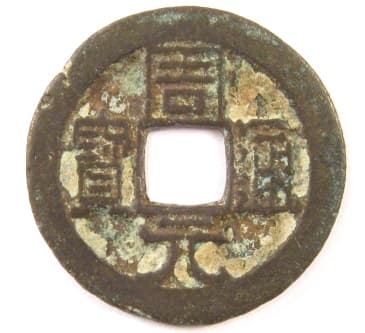
Emperor Shi Zong's coin is displayed to the left. The inscription reads zhou yuan tong bao (周 元通宝) which translates as the "Zhou First Currency" and was cast during the years 951-960 AD.
The zhou yuan tong bao very quickly became a popular inscription used on Chinese charms.
The reason is because, beginning in the year 956, Emperor Shi Zong ordered that the bronze Buddha statues in the Buddhist temples, as well as the bronze items owned by the people, be turned in to the government so that they could be melted down and used to cast coins. As a result, coins with this inscription are considered especially auspicious because they contain metal from Buddhist statues.
This belief has carried over to the charms and amulets cast during the following centuries which display the same inscription.
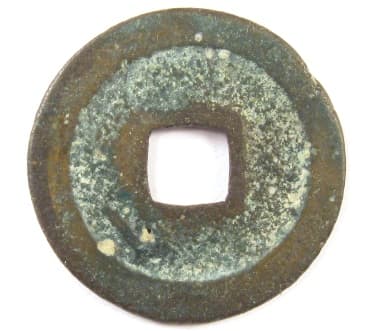
The reverse side of the coin shows a "moon" between the square hole an the rim at the seven o'clock position. For a discussion of the "moon" symbol please visit Charm Symbols: Star, Moon, Cloud and Dragon.
The coin has a diameter of 24 mm and a weight of 3.5 grams.
Emperor Shi Zong of the Later Zhou issued his coinage patterned on that of the kai yuan tong bao (开元通宝) which had become the standard coin of the Tang Dynasty.

Emperor Shi Zong's coin is displayed to the left. The inscription reads zhou yuan tong bao (周 元通宝) which translates as the "Zhou First Currency" and was cast during the years 951-960 AD.
The zhou yuan tong bao very quickly became a popular inscription used on Chinese charms.
The reason is because, beginning in the year 956, Emperor Shi Zong ordered that the bronze Buddha statues in the Buddhist temples, as well as the bronze items owned by the people, be turned in to the government so that they could be melted down and used to cast coins. As a result, coins with this inscription are considered especially auspicious because they contain metal from Buddhist statues.
This belief has carried over to the charms and amulets cast during the following centuries which display the same inscription.

The reverse side of the coin shows a "moon" between the square hole an the rim at the seven o'clock position. For a discussion of the "moon" symbol please visit Charm Symbols: Star, Moon, Cloud and Dragon.
The coin has a diameter of 24 mm and a weight of 3.5 grams.
The obverse side of this charm closely resembles that of the coin above and the inscription, zhou yuan tong bao (周元通宝), is the same.
Although this charm is from a later period, charms with this Chinese coin inscription are very popular.
Because the actual coins with this inscription were cast using bronze from Buddhist statues, the Chinese believed that this was also true for charms and amulets with the same inscription even though they may have been cast in the following centuries.

The reverse side of this old charm has a dragon on the left and a phoenix on the right.
The two are facing each other with their heads at the bottom of the charm.
Charms with a dragon and phoenix are considered auspicious marriage charms.
For additional information on this theme, please visit Chinese Marriage Charms.
The diameter of the charm is 22.5 mm and the weight is 5.6 grams.

Like the charm above, the obverse side of this charm has the auspicious Chinese coin inscription zhou yuan tong bao (周元通宝).

This is the reverse side of the charm revealing that it is another phoenix and dragon marriage charm.
In this example, however, the phoenix is on the left and the dragon is on the right. The two are facing each other with their heads at the top of the charm.
It is a little difficult to see but the wings of the phoenix are just to the left of the square hole. The head is at the eleven o'clock position and the tail feathers are at the seven o'clock position.
The dragon is on the right with the tip of its mouth at the twelve o'clock position and a dot representing its left eye at the one o'clock position. Its left front claw is just above the square hole. The dragon's body curves down the right side of the charm and its left rear claw is just below the central hole. Its tail is almost touching the upper tail feather of the phoenix.
The charm has a diameter of 25 mm and a weight of 6.6 grams.

This is the obverse side of another ancient charm based on the zhou yuan tong bao (周元通 宝) coin of the Later Zhou Dynasty.

Similar to the example above, the dragon is on the right and the phoenix is on the left.
The two mythical animals are sculpted in high relief and are facing each other with their heads at the top of the charm.
This charm has a diameter of 23.5 mm and a weight of 6.8 grams.
Song Dynasty
(960-1279)

The coin displayed at the left is an example of coins with the inscription tai ping tong bao (太 平通宝) cast during the years 976-989 of the reign of Emperor Tai Zong (976-997) of the Northern Song Dynasty.
This was the first Song Dynasty coin inscribed with an imperial or reign title.
The reign title tai ping (太 平) means "peace".
This same inscription, tai ping tong bao (太 平通宝), was also used on coins cast during the years 1854-1855 by the Shanghai Small Sword Society (xiao dao hui 小刀会) during the Taiping Rebellion (1850-1864).
The coin has a diameter of 24.8 mm and weighs 4 grams.

This is a charm based on the tai ping tong bao (太 平通宝) coin of the Song Dynasty.
Tai ping, meaning "peace" or "great peace", has always been a strong desire of a people and it is, therefore, an appropriate inscription for a charm.
This is an unusually well-made charm as evidenced by the fine crosshatch pattern seen in the character field.
The charm appears to be made of tin with, possibly, a silver wash.
 The
reverse side of the charm displays a number of
auspicious symbols, some of which are
difficult to identify.
The
reverse side of the charm displays a number of
auspicious symbols, some of which are
difficult to identify.At the top is a pair of interlocking diamond-shaped lozenges known as fang sheng (方胜). The origin of this symbol is still unclear but it may represent the form of an ancient musical instrument. Or, it may have been a head ornament worn in ancient times which symbolized victory. There is also a legend that the Queen Mother of the West wore such as object to exorcise evil spirits.
Moving clockwise, the next symbol appears to be books tied with a ribbon or fillet possibly expressing the wish for sons to be successful in the imperial exams and obtaining an official government position.
The next symbol is a gourd also tied with a ribbon. The gourd is popular symbol to ward off evil spirits and disease because its first character (hulu 葫芦) has the same pronunciation as to "protect" or "guard" (hu 护), and also for "blessing" (hu 祜). (Please see Gourd Charms.)
Unfortunately, corrosion obscures the symbols at the bottom and left of the square hole and these symbols remain unidentified.
Just to the left of the lozenges is a flaming pearl which represents riches and wealth.
This charm has a diameter of 26 mm and a weight of 3.3 grams.
Liao Dynasty
(916-1125)

At the left is a fairly rare coin charm from the Liao Dynasty.
According to historical records, Emperor Tai Zong (太宗) in the year 938 established the capital at Shang Jing (上京) and honored the event by casting commemorative coins with the auspicious inscription qian qiu wan sui (千秋万岁), which literally translates as a "thousand autumns and ten thousand years", expressing the hope that the emperor and the dynasty would endure forever.
Most of these commemorative coins were presented as gifts or awards. Some of the coins have also been found in the foundations of Liao Dynasty pagodas where they were presented as offerings by religious believers during the dedication of the religious buildings.

The reverse side displays an interesting set of three figures.
At the very top is a figure of a person kneeling with his right and left arms stretched out.
To the left of the square hole, and below the above figure's right arm, is a person, perhaps a newborn child, bent forward and standing.
To the right of the hole, and below the top figure's left arm, is a dragon.
This Liao Dynasty coin has a diameter of slightly greater than 25 mm and a weight of 6.8 grams.
Jin Dynasty
(1115-1234)

During the late Northern Song Dynasty, the Nuzhen (Jurchen, Jurched) (女真) nationality conquered most of north China and established their rule as the Jin Dynasty.
At first, they used coins of the Song and Liao dynasties but began to cast their own coinage in 1157.
The coin at the left, with the beautiful seal script calligraphy, has the inscription tai he zhong bao (泰和重宝).
The coin was cast during the years 1204-1209 of the reign of Emperor Zhang Zong (1190-1209) of the Jin Dynasty.

This is actually a charm based on the Jin Dynasty tai he zhong bao coin shown above.
Because tai he (泰和) can be variously translated as "peace and harmony" or "prosperity and harmony", the coin became popular as a theme upon which to base charms and amulets.
Tai (泰) can also refer to tai shan (泰 山), or Mt. T'ai, which is a famous and sacred mountain worshipped as a god.
 The reverse side of
the charm depicts two magpies with
their long tail feathers. The magpie above the
square hole is actually upside down. Its head is
looking down and back to the right.
The reverse side of
the charm depicts two magpies with
their long tail feathers. The magpie above the
square hole is actually upside down. Its head is
looking down and back to the right.The magpie at the bottom has its head at the four o'clock position and is looking up and to left.
The two magpies are therefore looking directly at each other.
The magpie (xi que 喜 鹊) symbolizes "happiness" because the first character xi is the same as the word "happy" (xi 喜). Two magpies facing each other therefore represents "double happiness" (shuang xi 喜喜) and is a symbol of a happy marriage.
The reference to a happy marriage is based on the legend of two heavenly lovers, the Cowherd (Oxherd) and the Weaver Girl (Maiden), who are permitted to meet each other only once a year on the seventh day of the seventh month (known as qixi 七夕, the Double Seven, or Sisters Festival) by crossing a celestial river (the Milky Way) on a bridge made of magpies.
Also, a magpie shown upside down, as is the case here, means that happiness has "arrived" because the Chinese words for "upside down" (倒) and "arrived" (到) are both pronounced dao.
Located between the two magpies are plum branches. In Chinese, one can say "there is a happy bird (magpie) on the tip of the plum branch" as xi shang mei shao (喜上梅稍). This sounds exactly the same as saying xi shang mei shao (喜上眉稍), meaning "happiness up to one's eyebrows", which is a Chinese expression for "very happy".
This charm has a diameter of 41 mm and a weight of 18.8 grams.

This is the obverse side of another charm based on the famous tai he zhong bao (泰和重宝) coin of the Jin Dynasty.

The reverse side of the charm has four lines radiating outward from the corners of the square hole and extending to the rim.
The Chinese refer to this characteristic as si chu (四出). Si (四) means "four" and chu (出) means "going out".
The implied meaning is that peace, prosperity and harmony should radiate in all directions.
The charm has a diameter of 41 mm and a weight of 22.3 grams.
Ming Dynasty
(1368-1644)
 This coin was
cast during the reign of the first emperor of the Ming
Dynasty.
This coin was
cast during the reign of the first emperor of the Ming
Dynasty.The inscription is hong wu tong bao (洪武通宝) and was cast during the Hong Wu reign of Emperor Tai Zu (1368-1398).
You will notice that the hole is not in the usual shape of a four-sided square. This particular specimen has an auspicious eight-sided hole known as a "flower" or "rosette" hole.
"Flower hole" coins were fairly common during the Northern Song and early Southern Song Dynasties but became very rare by the time of the Ming Dynasty.
A detailed discussion of these types of coins including many examples can be seen at Chinese Coins with Flower Holes.

This is a Chinese charm, modeled after the above Ming Dynasty coin, with the same inscription hong wu tong bao (洪武通宝).
 The
reverse side of the charm shows a boy riding an ox or
water
buffalo.
The
reverse side of the charm shows a boy riding an ox or
water
buffalo.In this case, the "boy" is actually Emperor Tai Zu.
Emperor Tai Zu had a very humble early life and for a time was a shepherd boy.
You will notice that the boy is playing a flute which has the connotation of a care free life.
The flute is an old Daoist (Taoist) symbol which is associated with the Daoist Immortal Lan Caihe (蓝采和).
The flute is also an ancient Buddhist symbol used in meditation and is displayed on this charm to allude to the time when Emperor Tai Zu lived in a Buddhist monastery.
This type of charm became popular with the Chinese people because it represented the hope that a person could become successful despite being born into a peasant family.
Another hong wu tong bao charm which displays a number of symbols referring to Emperor Tai Zu's life is discussed in detail at Buddhist Charms.
This charm has a diameter of 43 mm and a weight of 29.2 grams.

The inscription (legend) on this charm is zheng de tong bao (正德通宝).
Zheng De was the reign title (1505 - 1521 AD) of the Ming Dynasty Emperor Wu Zong. While some claim that the government did cast a very small number of coins with this inscription, it is generally believed that no coins meant for circulation were ever cast by the government using the reign title zheng de.
Even though no legal tender coins were cast during this period, a fairly large number of charms with this inscription exist. The reason is that zheng de has the auspicious meaning in Chinese of "correct virtue", so the inscription translates as "currency of correct virtue".
Many Chinese of the time also believed that Emperor Wu Zong was the reincarnation of a real dragon.
Ancient Chinese folklore says that zheng de was a "swimming" dragon. The belief is that wearing a zheng de charm when you cross a river or sea will protect you from the danger of large waves.
The Chinese also love to gamble and there is an old Chinese superstition that says carrying a zheng de charm will bring you good luck at gambling.
It was believed that if a pregnant woman carried a zheng de charm in her hand both she and her child would be protected.
Zheng de charms were also given to children as a form of good luck money (yasuiqian 压岁钱) during the lunar New Year.
The zheng de charms were considered so lucky that there was this popular saying:
家有正德钱富贵万万年
(jia you zheng de qian fu gui wan wan nian)
"If a family has a zheng de coin, there will be riches and honor for ten thousand years"
(jia you zheng de qian fu gui wan wan nian)
"If a family has a zheng de coin, there will be riches and honor for ten thousand years"

It is a common theme with zheng de charms to have a dragon and phoenix.
The reverse side of this charm shows a wide-eyed dragon on the right with its head at the five o'clock position. A lovely phoenix is on the left of the square hole with its head at the six o'clock position.
The dragon and phoenix paired together represent the ultimate union of a man and a woman. Additional information on this subject can be found at Chinese Marriage Charms.
The charm has a diameter of 45 mm and weighs 14.5 grams.

This is another example of a very well-made zheng de tong bao (正德通宝) that would typically have been used as a marriage charm.

The reverse side of the charm displays a very ornate and finely detailed dragon on the right with its head at the two o'clock position.
An equally detailed phoenix is at the left of the center hole with its head at the eight o'clock position.
This is a large and heavy charm.
The diameter is 54 mm and the weight is 42.3 grams.

This is another example of a charm with the Chinese coin inscription zheng de tong bao (正 德通宝).
The very broad outer rim displays a dragon on the left and a phoenix on the right.
The circular objects at the 12 o'clock and 6 o'clock positions are pearls.

The reverse side also has a very broad outer rim with the single Chinese character wen (文) above the square hole.
Wen (文) is the measure word used for counting Chinese cash coins.
It is interesting that this same character wen (文) can also mean the obverse side of a coin even though here it is displayed on the reverse side.
The diameter of this charm is 31.3 mm and the weight is 8.3 grams.

Coins were cast with the reign title Wan Li (万历) of Emperor Shen Zong during the years 1573-1620 of the Ming Dynasty.
At the left is a coin with the inscription wan li tong bao (万历通宝).
What is unusual about this coin is that there are four dots, with one dot between each of the Chinese characters.
Experts seem to be divided as to whether this is an official coin or a charm.
The character wan (万) means "ten thousand" and the character li (历) means "era" or "calendar". The four dots are generally believed to represent stars (xing 星) or suns (ri 日). The implied meaning is, therefore, light and brightness forever.

The reverse side of this coin or charm is blank although it has the same broad outer rim as that on the obverse.
The coin has a diameter of 24 mm and a weight of 3.4 grams.
Qing (Ch'ing) Dynasty
(1644-1911)

This coin is a qian long tong bao (乾隆通宝) presumably cast during the 60 year reign (1736-1795) of Qing (Ch'ing) Dynasty Emperor Gao Zong.
The coin is very large and heavy. In fact, it is much larger and heavier than any other qian long tong bao variety of coin with which I am familiar.
Also, the characters, such as the bottom portion of the bao (宝) and the radical portion of the tong (通), are written in a slightly different style from that of the other coins of this emperor.
The coin, however, is clearly old.
Because of its size, calligraphy and age, I have concluded that this "coin" is most probably a "charm".

The reverse side reveals another interesting feature.
The Manchu characters indicate that the piece was cast at the Board of Revenue in Peking (Beijing).
However, the characters are rotated 90 degrees clockwise and the characters themselves are very large.
The intention may have been political but the meaning remains unclear.
The charm has a diameter of almost 56 mm and a thickness of just over 3 mm.
In 1861, a few
specimen coins for the reign title Qixiang were
cast with the inscription qi xiang zhong bao
(祺祥重宝).
The coin at the left is either one of these authentic pieces or an excellent copy. If it is indeed a copy, then it is clearly a very old one.
Besides its rarity, coins or charms with the inscription qi xiang are considered auspicious because qi xiang (祺 祥) means "lucky" or "of good omen".
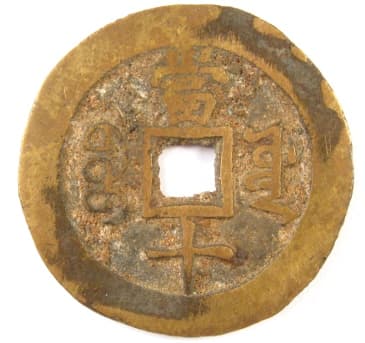
The top and bottom characters on the reverse side of this coin/charm are dang shi (当十) which translates as "Value Ten" and means that this coin was worth the equivalent of 10 cash coins.
The Manchu characters to the right and left of the square hole indicate that the coin was cast at the Board of Works in Peking (Beijing).
This coin/charm has a diameter of 35 mm and weight of 13.6 grams.
The coin at the left is either one of these authentic pieces or an excellent copy. If it is indeed a copy, then it is clearly a very old one.
Besides its rarity, coins or charms with the inscription qi xiang are considered auspicious because qi xiang (祺 祥) means "lucky" or "of good omen".

The top and bottom characters on the reverse side of this coin/charm are dang shi (当十) which translates as "Value Ten" and means that this coin was worth the equivalent of 10 cash coins.
The Manchu characters to the right and left of the square hole indicate that the coin was cast at the Board of Works in Peking (Beijing).
This coin/charm has a diameter of 35 mm and weight of 13.6 grams.

The charm to the left is quite small and shows considerable wear.
The inscription is guang xu tong bao (光绪通宝) and the obverse side looks exactly like a typical Qing (Ch'ing) Dynasty coin of Emperor De Zong (1875 - 1908 AD).

The reverse side reveals that it is actually a charm with the inscription read top to bottom and right to left as ding cai gui shou (丁财贵寿).
The translation is "May you acquire wealth, honor (high rank) and longevity".
The charm is only 19.5 mm in diameter and weighs 4.7 grams.
If you have a further interest in the close relationship of Chinese coins and Chinese charms, please also visit Chinese Coins with Charm Features.
Return to Ancient Chinese Charms and Coins
